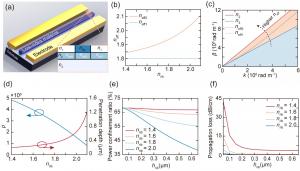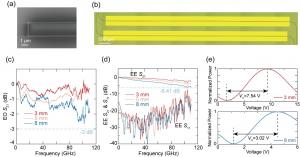
Fig. 1 Schematic and theoretical results of strong-confinement rib-loaded waveguide. (a) Schematic of strong-confinement rib-loaded waveguide with electrodes. The inset shows the cross-section view of the structure. (b) neff1 and neff2 as functions of different nrib.
By alleviating the etching of novel thin films, the proposed structure opens up new ways of fast proof-of-concept demonstration.
CHENGDU, SICHUAN, CHINA, September 16, 2025 /EINPresswire.com/ — As modern communication and sensing systems demand ever higher speeds and efficiencies, integrated photonics has emerged as a critical enabling technology. Thin-film lithium niobate (TFLN), known for its exceptional electro-optic and second-order nonlinear properties, is poised to become the material of choice for high-performance modulators and frequency converters.
However, manufacturing TFLN-based devices typically relies on dry etching processes, which suffer from low selectivity, limited reproducibility across different tools, and long recipe development cycles. These challenges become more severe when working with novel materials like barium titanate (BTO), impeding rapid prototyping and mass production.
A promising alternative is rib-loaded waveguide structures, where a patterned rib atop the thin film guides light propagation. Unfortunately, conventional rib materials with refractive indices similar to TFLN divert significant optical power from the electro-optic layer, reducing modulation efficiency. Another technique, bound state in the continuum (BIC) can tightly confine light in TM-polarized modes, incompatible with TFLN’s strongest electro-optic response to TE mode.
To overcome these limitations, a novel waveguide concept has been introduced: the strong-confinement low-index rib-loaded waveguide. By employing a low-index silica rib, this design ensures effective TE mode confinement within the TFLN slab, offering strong electro-optic coupling without direct thin-film etching.
Research Highlight:
Prof. Yang Li’s group from Sun Yat-sen University, together with collaborators from Tsinghua University and AFR Ltd., demonstrated this novel strong-confinement low-index rib-loaded waveguide structure. The study, entitled “Strong-confinement low-index-rib-loaded waveguide structure for etchless thin-film integrated photonics”, appears in Opto-Electronic Advances (2025, Early View).
The breakthrough lies in combining a low-index SiO₂ rib with carefully optimized rib height, width, and film thickness to achieve strong optical confinement, low propagation loss, and high electro-optic coupling in TE polarization. The team fabricated an electro-optic modulator based on this structure, achieving a 3-dB bandwidth beyond 110 GHz and a voltage-length product of 2.26 V·cm, matching state-of-the-art etched TFLN modulators while dramatically simplifying the fabrication process.
The work also presents designs for passive components including Y-splitters and multimode interference couplers, using the same waveguide concept, establishing it as a universal building block for thin-film photonic integrated circuits.
This technique can achieve fast integration of various emerging nonlinear materials such as BTO, paving the way for faster, cost-effective development of advanced photonic devices for data communications, LiDAR, and quantum technologies.
About the Research Group:
Yang Li received B.S. degree in telecommunication engineering (2006) and M.S. degree in electromagnetic field and microwave technology (2008) from Huazhong University of Science and Technology, China, and Ph.D. degree in Electrical Engineering (2012) from Iowa State University. He was a Postdoctoral Fellow at Harvard University from 2013 to 2018. He was an Associate Professor of the Department of Precision Instrument at Tsinghua University. In 2025, he joined the School of Electronics and Information Technology, Sun Yat-sen University as a Professor. His current research interests include integrated photonics-based metrology, integrated lithium-niobate photonics, and integrated zero-index metamaterials. He published several papers on high-impact journals including Nature Photonics, Nature Communications, Advanced Materials, eLight, Light: Science and Applications, and Optica. Seven of his journal papers were featured as cover stories. One was ESI hot paper. Two were ESI highly cited papers. Two of his papers have been cited over 200 times on Web of Science. He received the first-class award of excellent faculty advisor of Tsinghua University, the IEEE Antennas and Propagation Society Doctoral Research Award, and was nominated for the R.W.P. King Award.
Read the full article here: https://www.oejournal.org/oea/article/doi/10.29026/oea.2025.250056
Andrew Smith
Charlesworth
+44 7753 374162
marketing@charlesworth-group.com
Visit us on social media:
LinkedIn
YouTube
Other
Legal Disclaimer:
EIN Presswire provides this news content “as is” without warranty of any kind. We do not accept any responsibility or liability
for the accuracy, content, images, videos, licenses, completeness, legality, or reliability of the information contained in this
article. If you have any complaints or copyright issues related to this article, kindly contact the author above.
![]()





